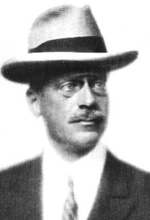Édouard Alphonse James de Rothschild
Édouard Alphonse James de Rothschild (nickname Édouard de Rothschild , born February 24, 1868 in Paris , † June 30, 1949 ibid) was a member of the French branch of the Rothschild family and worked as a banker , art collector and horse breeder .
Life
Édouard de Rothschild was the only son of the banker Alphonse de Rothschild (1827-1905) and his cousin Leonora de Rotschild (1837-1911), a daughter of Lionel de Rothschild from the English branch of the Rothschild family.
In 1887/88 he did his military service. He became an officer in the reserve and in 1913 dismissed as a lieutenant in the cavalry . At the Olympic Games in Paris in 1900 he won the bronze medal in polo with the team of the Bagatelle Polo Club de Paris , and he also took part in the sailing competitions at these games with his yacht .
After his father's death, he inherited the Rothschild Frères bank . He also inherited shares in the Château Lafite-Rothschild winery and his father's collection of paintings, which he expanded. He married Germaine Halphen (1884-1975), daughter of the married couple Emile Halphen (engineer and banker) and Louise Fould (niece of Fernand Halphen ). They had three children: Guy , Jacqueline, and Bethsabée de Rothschild .
Alphonse de Rothschild was president of the Consistoire central israélite , the highest organization of Judaism in France, from 1911 to 1940 .
When France became a place of refuge for many Jews from Germany and Austria as a result of the pogroms in Germany, Édouard Rothschild's wife Germaine set up Ferrières-en-Brie Castle in March 1939 as accommodation for 150 persecuted people. After the occupation of France in 1940, Édouard Rothschild and part of his family fled France. In 1939, Rothschild’s son Guy joined the French Army , daughter Jacqueline fled to the USA with her husband Gregor Piatigorsky . Before Édouard Rothschild left France, he tried unsuccessfully to hide his picture gallery at his Haras de Meautry stud in Touques and in his castle in Reux . But the Wehrmacht discovered and confiscated the paintings on the stud farm and on the castle. His collection included the world-famous painting The Astronomer by Jan Vermeer . The picture was confiscated by the Einsatzstab Reichsleiter Rosenberg in 1940 after the Nazis marched into France . After the end of the Second World War , the painting was restituted to the Rothschilds and assigned to the Louvre in 1982 - as a credit against inheritance tax .
The Wehrmacht also confiscated the stud's racehorses and brought them to the Altefeld Army Stud ; among them was the champion horse Brantôme. As in 1870 - here Jules Favre asked unsuccessfully to spare Paris on September 19 and 20, 1870 - the castle Ferrières-en-Brie was again occupied by German troops, but this time also looted and practically his entire art collection was stolen.
Édouard Rothschild emigrated on June 23, 1940 with his wife and daughter Bethsabée via Lisbon , Portugal to New York . On December 6, 1940, his French citizenship was revoked; by order of April 18, 1943, he received it back.
In 1944 he returned to France with his wife and son Guy. His art collection was returned to him. After his death in 1949, his son Guy de Rothschild became heir to the bank, the art collection and the castles. Ferrières-en-Brie Castle, which stood empty until 1959, was made habitable again after 1959 by Guy de Rothschild, who had spent his childhood here.
Honors
- In 1907 he became a knight, an officer in 1920 and commander of the Legion of Honor in 1930 .
- According to him, Rothschild Iceland , an island in Antarctica named.
literature
- Herbert R. Lottman: The French Rothschilds. The great banking dynasty through two turbulent centuries . Crown Publishers, New York. 1995, ISBN 0-517-59229-0 .
- Niall Ferguson: The world's banker. The history of the House of Rothschild . Weidenfeld & Nicolson 1998, ISBN 0-297-81539-3 .
Web links
- Jewish collectors and art dealers (victims of National Socialist persecution and expropriation): Édouard de Rothschild at lostart.de
Individual evidence
- ^ Document in the French National Archives .
- ^ Hector Feliciano: The Lost Museum. About art theft by the Nazis. Aufbau-Verlag, Berlin 1998, ISBN 3-351-02475-4 , pp. 17-19. 47-48. 175. 214.
- ^ Hector Feliciano: The Lost Museum. About art theft by the Nazis. Aufbau-Verlag, Berlin 1998, ISBN 3-351-02475-4 , pp. 47–54, 123, 175–176, 214.
- ^ Document in the French National Archives .
- ^ Document in the French National Archives .
- ↑ Documents for admission to the Legion of Honor on the website of the French National Archives.
| personal data | |
|---|---|
| SURNAME | Rothschild, Édouard Alphonse James de |
| ALTERNATIVE NAMES | Rothschild, Baron Édouard Alphonse James de (full name); Rothschild, Édouard |
| BRIEF DESCRIPTION | French banker |
| DATE OF BIRTH | February 24, 1868 |
| PLACE OF BIRTH | Paris |
| DATE OF DEATH | June 30, 1949 |
| Place of death | Paris |



